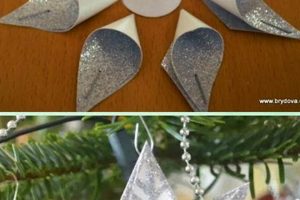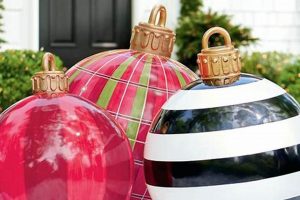Creating personalized holiday decorations from timber offers a fulfilling and cost-effective alternative to mass-produced items. This process allows individuals to design and craft unique embellishments for their Christmas trees, reflecting personal style and creativity. Examples range from simple shapes cut from plywood to intricate designs carved from solid hardwoods.
The practice of fashioning seasonal adornments by hand provides several advantages. It reduces reliance on commercial products, promotes resourcefulness, and fosters a sense of accomplishment. Historically, handmade decorations have been a significant part of Christmas traditions, symbolizing family unity and personal expression. The use of natural materials like timber adds a rustic and organic element to holiday displays.
The following sections will explore various techniques and ideas for fashioning festive decorations from timber, covering aspects such as material selection, tool usage, design inspiration, and finishing methods.
Crafting Exceptional Timber Holiday Adornments
The following guidelines provide essential advice for achieving optimal results when creating decorations from timber. Adherence to these principles will enhance the quality and longevity of the finished pieces.
Tip 1: Select Appropriate Timber: Opt for softwood species such as pine or basswood for ease of carving and shaping. Hardwoods like oak or maple provide greater durability but require specialized tools and techniques.
Tip 2: Employ Precise Cutting Techniques: Utilize a scroll saw or band saw for intricate designs. Ensure blades are sharp and appropriate for the timber thickness to minimize splintering and ragged edges.
Tip 3: Implement Proper Sanding Procedures: Begin with coarse-grit sandpaper (e.g., 80-grit) to remove imperfections, progressing to finer grits (e.g., 220-grit) for a smooth finish. Sand with the grain to avoid unsightly scratches.
Tip 4: Apply Finishes Judiciously: Choose non-toxic paints, stains, or varnishes specifically formulated for wood. Multiple thin coats are preferable to a single thick coat to prevent drips and ensure even coverage.
Tip 5: Securely Attach Hanging Hardware: Use small eye screws or pre-drilled holes for attaching string or ribbon. Reinforce attachment points with wood glue for added stability.
Tip 6: Consider Personalization Options: Incorporate wood burning techniques, stencils, or hand-painted details to create unique and personalized embellishments.
Tip 7: Prioritize Safety Measures: Always wear safety glasses and a dust mask when cutting, sanding, or finishing timber. Ensure adequate ventilation to prevent inhalation of harmful fumes.
Following these recommendations will contribute to the creation of aesthetically pleasing and durable decorations, enhancing the overall quality of the festive display.
The subsequent sections will delve into diverse design ideas and inspirational projects, encouraging further exploration of the possibilities in crafting timber holiday adornments.
1. Timber Selection
The selection of appropriate timber is paramount when undertaking the construction of handmade festive adornments. This choice directly influences the ease of fabrication, the aesthetic appeal of the finished piece, and its longevity.
- Softwood vs. Hardwood Properties
Softwoods, such as pine and fir, offer ease of workability due to their lower density, facilitating carving and shaping. Conversely, hardwoods like oak and maple provide superior durability and resistance to wear, although they require specialized tools and techniques for manipulation. The project’s complexity and intended lifespan should guide the decision between softwood and hardwood.
- Grain Pattern and Aesthetics
The grain pattern of the timber significantly contributes to the visual appeal of the finished ornament. Straight-grained woods like basswood provide a uniform surface for painting or staining, while figured woods, such as curly maple, add visual interest through their natural patterns. Considering the desired aesthetic is crucial when selecting timber.
- Timber Stability and Moisture Content
Timber stability, influenced by its moisture content, impacts the ornament’s resistance to warping and cracking over time. Kiln-dried timber with a low moisture content is preferable, as it minimizes dimensional changes. Proper acclimatization of the timber to the environment where the ornament will be displayed is also important.
- Sustainability and Ethical Sourcing
Choosing timber from sustainable sources promotes responsible forestry practices and reduces environmental impact. Opting for reclaimed or salvaged timber can further minimize the carbon footprint associated with crafting holiday decorations. Verification of timber sourcing through certifications, such as the Forest Stewardship Council (FSC), is recommended.
In summation, mindful timber selection is integral to the success of creating handmade festive decorations. Careful consideration of wood properties, aesthetic characteristics, stability, and sustainability factors enhances the quality and enduring appeal of the finished product.
2. Design Conceptualization
Effective design is a prerequisite for successful realization of timber-based holiday embellishments. The conceptual phase establishes the aesthetic and functional parameters that guide the subsequent crafting process.
- Theme and Style Selection
Choosing a cohesive theme (e.g., traditional, modern, rustic) dictates the overall appearance of the ornaments. Style selection, whether geometric, representational, or abstract, influences the complexity and visual impact. Mismatched themes or styles can detract from the overall aesthetic coherence.
- Form and Dimension Planning
Determining the shape (e.g., star, bell, angel) and size of each ornament is crucial. Overly large ornaments may overwhelm the tree, while excessively small ones may lack visual impact. Scale and proportion should be carefully considered in relation to the tree’s size and the number of ornaments to be displayed.
- Material and Color Palette
The selection of appropriate timbers, finishes, and embellishments contributes to the visual harmony of the collection. Complementary color schemes enhance visual appeal, while contrasting colors can create a striking effect. Consideration should be given to the compatibility of different materials to ensure structural integrity and longevity.
- Functional Considerations
The design should account for the ornament’s weight and balance to ensure it hangs properly on the tree. Attachment points for hanging hardware should be strategically positioned to prevent the ornament from tilting or falling. Structural integrity should be prioritized to withstand handling and storage.
These facets of conceptualization are integral to achieving a well-executed collection of festive decorations. Failure to adequately address these elements can result in ornaments that are aesthetically unappealing, structurally unsound, or functionally inadequate. The design phase serves as the foundation upon which the success of the undertaking rests.
3. Cutting Precision
Achieving accurate cuts is indispensable for realizing aesthetically pleasing and structurally sound decorations. The level of precision directly impacts the finished ornament’s overall quality and visual appeal.
- Tool Selection and Calibration
The choice of cutting implement, such as a scroll saw, band saw, or laser cutter, dictates the potential level of accuracy. Proper calibration and maintenance of these tools are essential. For instance, a dull scroll saw blade will produce ragged edges and require excessive sanding, compromising the intended design. Regular blade replacement and machine calibration are therefore imperative.
- Template Utilization and Transfer
Employing templates, whether physical or digital, ensures consistency and accuracy across multiple ornaments. Templates must be transferred to the timber with precision, using methods such as carbon paper or adhesive stencils. Errors in template transfer will be magnified in the final product, leading to deviations from the intended design.
- Cutting Technique and Control
Consistent and controlled cutting techniques are vital. Maintaining a steady feed rate and following the template lines with accuracy minimizes errors. Rushing the cutting process or applying excessive pressure can result in uneven cuts and splintering, necessitating corrective measures that may alter the intended design.
- Kerf Allowance and Compensation
The kerf, or width of the cut made by the saw blade, must be accounted for in the design and cutting process. Failure to compensate for the kerf will result in ornaments that are smaller than intended or that do not fit together properly. Accurate kerf measurement and allowance are critical for achieving precise dimensions.
These facets of cutting precision are fundamental to crafting high-quality timber festive decorations. Imprecise cuts detract from the visual appeal, compromise structural integrity, and diminish the overall craftsmanship of the project. Prioritizing accuracy in cutting techniques enhances the aesthetic and functional value of the finished ornaments.
4. Sanding Technique
The sanding technique constitutes a critical stage in the fabrication of timber holiday embellishments. Its significance stems from its direct impact on the surface quality and, consequently, the overall aesthetic appeal of the finished product. Improper sanding can lead to visible imperfections, such as scratches, uneven surfaces, and compromised paint adhesion. For example, ornaments intended to feature a smooth, glossy finish require meticulous sanding with progressively finer grits of sandpaper. Conversely, ornaments aiming for a rustic aesthetic may utilize coarser grits to enhance the wood’s natural texture. The effectiveness of the sanding process dictates the degree to which the ornament achieves its intended visual characteristics.
Furthermore, proper sanding technique extends beyond mere surface aesthetics. It prepares the timber for subsequent finishing processes, such as painting, staining, or varnishing. A well-sanded surface provides an ideal substrate for these finishes, promoting optimal adhesion and preventing premature peeling or cracking. Ornaments intended for outdoor display, for instance, necessitate thorough sanding to ensure the protective coating provides adequate weather resistance. A practical application involves sanding sharp edges to mitigate splintering and enhance safety during handling and display. The uniformity and longevity of the final product are inextricably linked to the quality of the sanding process.
In summary, the sanding technique is an indispensable component of crafting decorative timber items. It influences not only the aesthetic qualities but also the functional performance and longevity of the finished ornaments. By understanding the cause-and-effect relationship between sanding technique and ornament quality, individuals can elevate the craftsmanship of their creations, ensuring they are both visually appealing and enduring symbols of the holiday season. The attention given to this detailed procedure contributes significantly to both the perceived value and actual durability of these projects.
5. Finishing Application
The finishing application represents a critical stage in the creation of timber Christmas adornments, serving to protect, enhance, and personalize the raw wood material. This process directly influences the aesthetic appeal, durability, and longevity of the finished decorative pieces.
- Protection Against Environmental Factors
Finishes, such as varnishes, sealants, and exterior paints, shield the timber from moisture, UV radiation, and temperature fluctuations. Untreated timber is susceptible to warping, cracking, and decay when exposed to varying environmental conditions. Applying a protective finish extends the lifespan of the ornament, ensuring its preservation for subsequent holiday seasons. For example, a clear coat varnish can safeguard against humidity in damp environments, preventing mold growth and structural damage.
- Enhancement of Aesthetic Properties
Finishing techniques, including staining, painting, and distressing, allow for customization of the ornament’s appearance. Stains accentuate the natural grain of the timber, while paints offer a wide range of color options for personalization. Distressing techniques create a rustic or antique appearance, adding character and visual interest. An example includes applying multiple layers of paint and sanding them back to reveal underlying colors, creating a worn and aged aesthetic.
- Provision of a Smooth and Tactile Surface
Sanding and finishing techniques contribute to a smooth and tactile surface, enhancing the ornament’s handling experience. A rough or splintered surface can detract from the aesthetic appeal and pose a safety hazard. Applying multiple coats of finish and sanding between applications results in a polished surface that is both visually appealing and comfortable to touch. For instance, a hand-rubbed oil finish can create a velvety texture, enhancing the tactile experience.
- Adherence of Decorative Elements
Certain finishes, such as lacquers or adhesives, facilitate the secure attachment of decorative elements, including glitter, beads, and fabric scraps. A proper finishing layer provides a stable and receptive surface for these embellishments, preventing them from detaching over time. An example is using a spray adhesive to adhere glitter to a painted surface, creating a sparkling effect.
In summary, the finishing application plays a pivotal role in the construction of handcrafted timber Christmas decorations. It imparts protection, enhances aesthetics, provides a smooth surface, and facilitates the attachment of decorative elements. The careful selection and application of appropriate finishing techniques contribute significantly to the overall quality and enduring appeal of these festive embellishments. They should be considered integral to the creative process, rather than simply an afterthought.
6. Assembly Method
The assembly method employed directly impacts the structural integrity, visual appeal, and overall durability of handcrafted timber holiday adornments. The joining techniques selected determine the ornament’s ability to withstand handling, storage, and display conditions. For instance, a poorly executed glue joint can fail under stress, causing the ornament to break apart, while a properly reinforced joint ensures long-term stability. Therefore, the assembly method is a critical component of these holiday crafts.
Different construction options are available, each with inherent advantages and disadvantages. Simple designs may utilize glue alone, while more complex constructions benefit from mechanical fasteners such as brads, screws, or dowels. Interlocking designs, such as those employing mortise and tenon or dovetail joints, offer enhanced structural strength but require specialized skills and tools. Choosing the appropriate approach depends on the ornament’s design, the timber’s characteristics, and the crafter’s skill level. The selection should prioritize a secure and aesthetically pleasing connection, ensuring that fasteners are concealed or integrated seamlessly into the overall design. The effectiveness of the assembly approach is paramount.
In conclusion, the assembly method is inextricably linked to the quality and longevity of homemade timber holiday adornments. Sound construction techniques are essential for ensuring that these decorations withstand the rigors of seasonal use and become cherished heirlooms. Understanding the cause-and-effect relationship between assembly and ornament integrity is critical for crafters seeking to create lasting and visually appealing pieces. Prioritizing robust and carefully executed assembly practices contributes significantly to the success and enjoyment of the craft.
7. Personalization Options
The capacity to tailor timber holiday adornments to individual preferences constitutes a significant advantage of engaging in their construction. This customization extends beyond mere aesthetics, encompassing sentimental value and reflecting unique personal narratives.
- Engraving and Wood Burning
These techniques permit the inscription of names, dates, or meaningful messages directly onto the timber surface. For instance, a family name and the year of creation can transform a simple ornament into a cherished keepsake. The permanence of engraving or wood burning ensures that the personalization endures over time, enhancing its sentimental value.
- Painting and Color Schemes
The selection of paints and color schemes allows for the creation of ornaments that complement existing holiday dcor or reflect individual tastes. A child’s favorite colors, or a color palette inspired by a specific memory, can be incorporated into the design. This level of control over the color palette is unattainable with mass-produced decorations, contributing to the uniqueness of the piece.
- Incorporation of Found Objects and Mixed Media
Personalization can extend to the inclusion of found objects, such as beads, buttons, or fabric scraps, transforming a simple timber base into a mixed-media artwork. A collection of seashells from a family vacation could be incorporated into an ornament, serving as a tangible reminder of the experience. The use of mixed media adds texture and visual interest, further distinguishing the ornament from commercially available alternatives.
- Themed Designs and Representations
Timber adornments can be designed to represent personal interests, hobbies, or beliefs. An ornament shaped like a musical instrument for a musician, or a miniature representation of a beloved pet, can add a personalized touch to the holiday display. These themed designs reflect the individual’s identity and create a connection between the holiday celebration and personal experiences.
These facets of personalization, when integrated into the creation of timber Christmas ornaments, elevate them from mere decorations to meaningful expressions of individuality and cherished mementos. The ability to imbue these objects with personal significance enhances their emotional value and ensures they are treasured for years to come.
Frequently Asked Questions
The following addresses common inquiries regarding the creation of decorative timber holiday items. This information aims to clarify potential challenges and enhance understanding of the crafting process.
Question 1: What timber types are best suited for constructing holiday adornments?
Softwoods, such as pine and basswood, are generally recommended due to their ease of workability. Hardwoods like oak and maple provide increased durability but require specialized tooling and advanced woodworking skills.
Question 2: How can splintering be minimized during timber cutting?
Utilizing sharp blades specifically designed for fine cuts, employing a backing board to support the timber, and controlling the feed rate of the cutting implement can mitigate splintering. Additionally, applying painter’s tape along the cut line can help prevent splintering on the surface.
Question 3: What sanding grits are appropriate for achieving a smooth finish on timber ornaments?
A multi-stage sanding process is recommended, beginning with a coarser grit (e.g., 120-grit) to remove imperfections and progressing to finer grits (e.g., 220-grit and higher) for a polished surface. Sanding should always be performed in the direction of the wood grain.
Question 4: What types of finishes are suitable for protecting timber ornaments from moisture and environmental damage?
Exterior-grade varnishes, sealants, and paints provide effective protection against moisture, UV radiation, and temperature fluctuations. Multiple thin coats are preferable to a single thick coat to ensure even coverage and prevent cracking.
Question 5: How can small components be securely attached to timber ornaments?
Wood glue, epoxy, and small brads or nails can be used to secure small components. Clamping the components during the adhesive curing process ensures a strong and durable bond. The selection of the appropriate adhesive depends on the materials being joined and the intended use of the ornament.
Question 6: What safety precautions should be observed when working with woodworking tools and finishes?
Eye protection, respiratory protection (dust mask or respirator), and appropriate ventilation are essential safety measures. Power tools should be operated in accordance with the manufacturer’s instructions, and all safety guards should be in place. Finishes should be applied in well-ventilated areas to minimize exposure to harmful fumes.
In summary, the creation of high-quality timber holiday adornments requires careful attention to material selection, cutting techniques, sanding procedures, finishing application, assembly methods, and safety precautions.
The subsequent section will explore resources and references for further exploration of timber crafting techniques.
Conclusion
The preceding sections have elucidated the multifaceted nature of crafting timber holiday decorations. From strategic timber selection to precise finishing applications, each stage contributes significantly to the ultimate quality and aesthetic of these handcrafted objects. Effective execution requires meticulous attention to detail and adherence to established woodworking principles. The potential for personalization further elevates these creations, transforming them into tangible expressions of individual creativity and cherished mementos.
Continued exploration of advanced techniques and innovative designs remains paramount. The enduring appeal of handmade decorations suggests a sustained interest in these crafts. This activity fosters resourcefulness, creativity, and a connection to traditional practices, underscoring its ongoing value in contemporary society.







